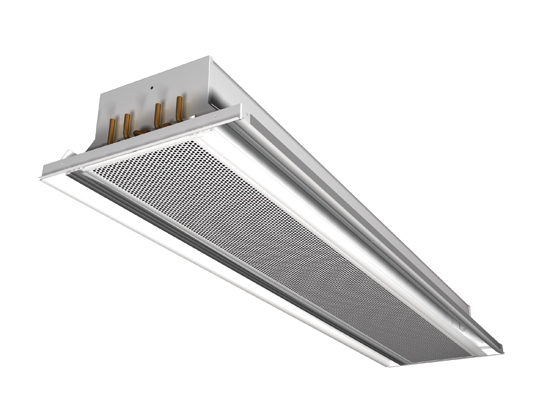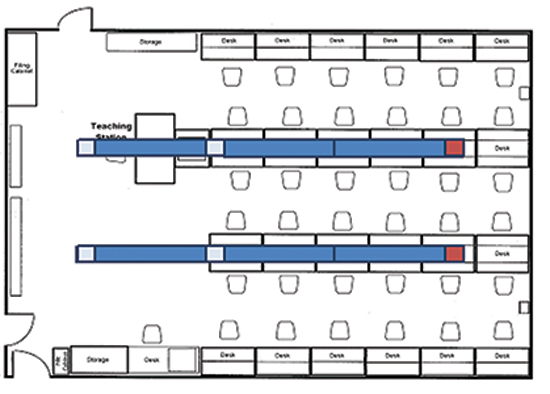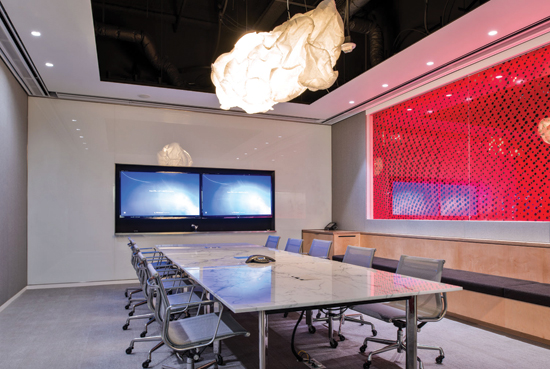Active Chilled Beams Come of Age
Designing with Active Chilled Beams
The integration of active beams in today's building can have a fairly industrial appearance or be fairly unobtrusive, depending on the type of beam and its placement in the occupied space. While traditional chilled beams have had a limited offering of finish options and configurations, this is changing as the product becomes more accepted. Common design options include frame and face style, beam location, induced air opening location, discharge opening location and type as well as the more traditional choices of color selection and frame style.
Frame style can have a significant impact on how well the beam fits with the surrounding ceiling. Options exist for different frame styles that allow the beam face to be flush with the surface for the various styles ceiling tile frames, making for a more consistent finish. Without proper specification, a beam designed to fit in a standard t-bar ceiling may arrive on site, resulting in a distinctly ill-coordinated appearance. In applications where beams are installed in a dry wall ceiling, plaster frames can be used with mud-in style frames offering a more polished look.
The most popular active chilled beam in the North American market is the linear beam. This beam is available in widths of 12 inches and 24 inches and a variety of lengths from 2 feet to 10 feet as a single piece. The linear beam is designed for easy integration in many different types of ceiling grid. The linear active beam can also be installed in a drywall ceiling or suspended from the building slab.
The selection of beam type and integration options may be constrained by the building type, programming, client, and climate. For example, laboratory spaces often have work benches running perpendicular to the façade. In these spaces, it is often desirable to run the mechanical system either above the benches to coordinate with the bench services, or above the aisles. The loads in laboratories will generally require many beams, which will occupy significant ceiling space.

Photo courtesy of Price Industries
The most popular active chilled beam in North America is the linear beam.
It is common in labs, as shown in the image below, to combine multiple beams into a large component, often by selecting options to minimize or eliminate the frames on the end, giving the face and the supply air slots a continuous appearance. It is also common practice to incorporate mechanical returns, controls access, or diffusers to help deliver make up air into the beam so that there are no additional devices in the ceiling which may take up additional space, or which could otherwise be hidden behind the face of the beam.
By so doing, the beam can be a continuous ceiling component while hiding other mechanical services that may be required as shown in the illustration of the linear beam. It is also possible to integrate the beam or beam array with an architectural ceiling system, though careful consideration and testing is often required in order to ensure that the chilled beams perform appropriately. Because of the way the beam works—using nozzles to induce room air over a coil—there must always be an induced air path, a discharge air path, and the required return for the mechanical system.

Image courtesy of Price Industries
Computer lab with beams
These concepts are not only well suited to laboratory spaces, they are also often used in commercial buildings. The option to combine multiple beams into one works well in many spaces. The accompanying figure shows a conference room in Gensler's Los Angeles studio which has several 12-inch wide beams installed end to end to create a single long beam along each wall.

Photo © Gensler / Ryan Gobuty
Gensler’s Los Angeles conference room features beams that have been installed end to end to create a single long beam along each wall.
San Francisco Public Safety Building: A Study in Chilled Beam Integration
The San Francisco Public Safety Building provides an excellent study in chilled beam integration. HOK + Mark Cavagnero Associates and ARUP worked closely with the chilled beam manufacturer to coordinate the beams within a wood slat ceiling system, as well as in perimeter bulkheads.
When placing chilled beams behind a wood slat or metal mesh ceiling, there are some key challenges to consider. The direction of the wood slats should not interfere with the air pattern of the beam. In most cases, this will mean having the beam installed perpendicular to the direction of the slats. The structure of the ceiling should not interfere with the air pattern of the beam. This often poses more challenges than the first consideration as this is generally also perpendicular to the slats. Coordination of this is generally done on a job-by-job basis in combination with laboratory testing to ensure occupant comfort and beam performance. When installing beams behind an architectural ceiling, care must be taken to ensure sufficient free area to allow for the induced air path as well as a path for the discharge air to reach the room below.
Cooling at the Building Perimeter
Curtain wall systems are commonly used in commercial buildings. In cases where the building also features a dropped ceiling, there is often a bulkhead to help transition from it to the ceiling height at the curtain wall. This creates an opportunity for beam installation. A one-way, horizontal style beam is ideal for this application because it tends to be higher capacity than a two-way discharge linear beam and features a one-way discharge pattern to handle the building skin loads.
HOK+ Mark Cavagnero Associates and ARUP used this beam, in combination with a slot diffuser and bar grille to hide the beam in the bulkhead at the SFPSB project. In concept, the bar grille, which was installed with a mud-in frame so that there would be no visible supports, serves as the induced air path for the beam. The slot diffuser was connected to the discharge of the beam to direct air towards the building façade.

Image courtesy of HOK + Mark Cavagnero Associates and ARUP
At the San Francisco Public Safety Building, the slot diffuser was connected to the discharge of the beam to direct air towards the building façade.
Several areas of coordination are required in this installation including detailing how the grille installs in the bulkhead and how the beam will perform with this grille and slot diffuser combination. An added complexity is incorporating a lighting fixture in the same space. When beams are connected to diffusers, it is critical to test the configuration as an assembly because the pressure drop through these devices can have a significant impact on beam performance. As discussed previously, if the pressure drop is too high, the amount of air induced through the beam coil is reduced and the cooling / heating capacity is lost.
To validate the configuration at SFPSB, the design team commissioned a mock-up to test constructability of the bulkhead assembly and to verify beam performance. Once completed, construction details were updated with the lessons learned and the job was constructed.
A few options are available with floor mounted beams, including various face options and finishes. When dealing with a one-way discharge floor mounted beam, integration in existing millwork or architectural features is often possible.
For the displacement cabinet beam in schools, integrating bookshelves and access sections can provide a visually appealing and functional wall-to- wall installation.
Single discharge beams are by far the easiest to integrate seamlessly in a variety of designs. The horizontal single discharge beam, for example, can easily be integrated in the bulkhead of a space. Slot diffusers or bar grilles can be used to hide the beam.
The vertical single discharge beam can also be installed behind the ceiling with a linear vane diffuser or slot diffuser. Return grilles can be located anywhere in the room to allow room air access to the ceiling plenum and to the beam coil.









